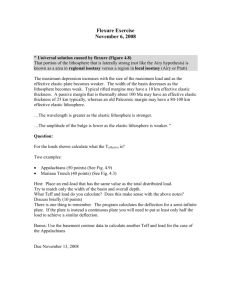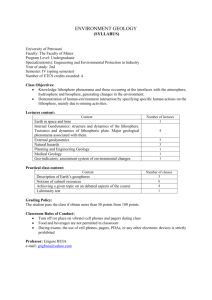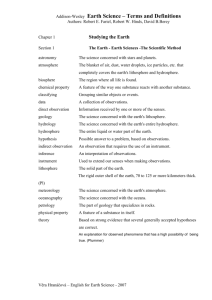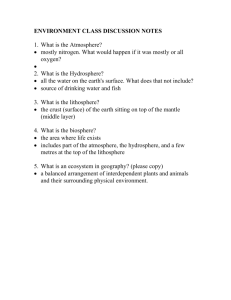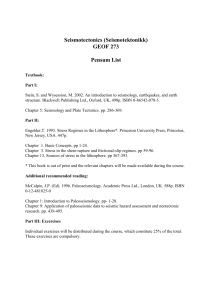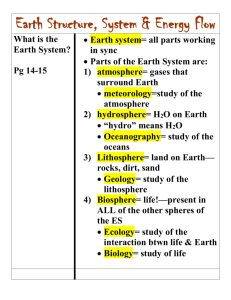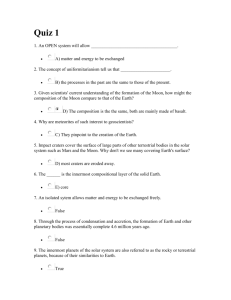Author's personal copy ⁎ F.O. Marques
advertisement
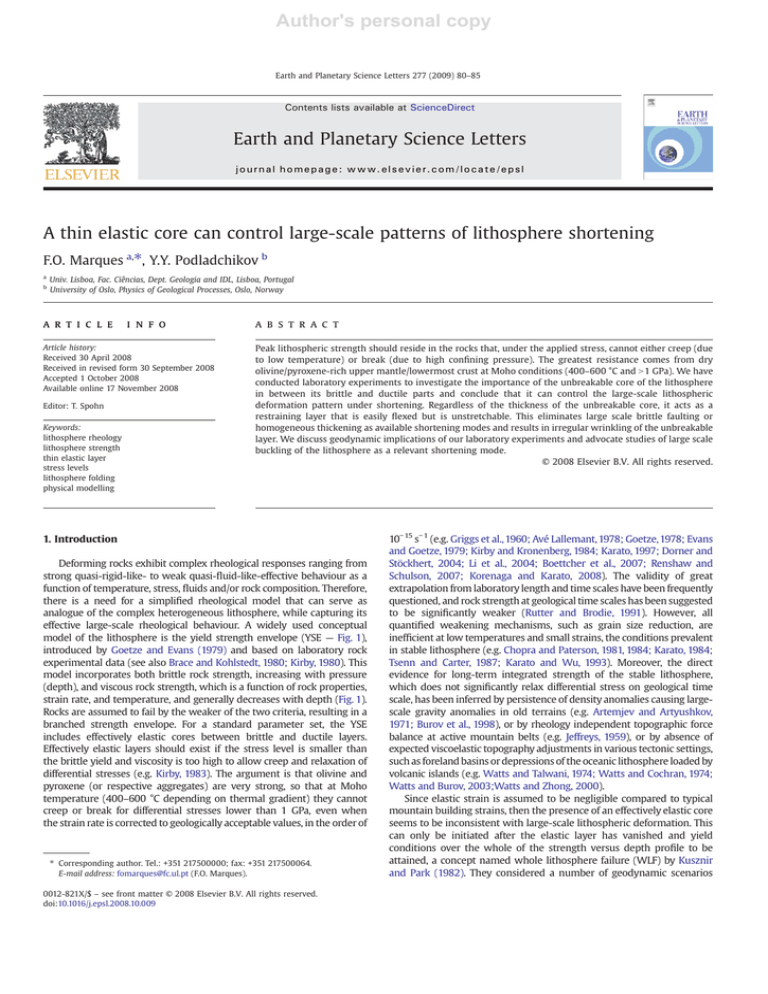
Author's personal copy Earth and Planetary Science Letters 277 (2009) 80–85 Contents lists available at ScienceDirect Earth and Planetary Science Letters j o u r n a l h o m e p a g e : w w w. e l s e v i e r. c o m / l o c a t e / e p s l A thin elastic core can control large-scale patterns of lithosphere shortening F.O. Marques a,⁎, Y.Y. Podladchikov b a b Univ. Lisboa, Fac. Ciências, Dept. Geologia and IDL, Lisboa, Portugal University of Oslo, Physics of Geological Processes, Oslo, Norway a r t i c l e i n f o Article history: Received 30 April 2008 Received in revised form 30 September 2008 Accepted 1 October 2008 Available online 17 November 2008 Editor: T. Spohn Keywords: lithosphere rheology lithosphere strength thin elastic layer stress levels lithosphere folding physical modelling a b s t r a c t Peak lithospheric strength should reside in the rocks that, under the applied stress, cannot either creep (due to low temperature) or break (due to high confining pressure). The greatest resistance comes from dry olivine/pyroxene-rich upper mantle/lowermost crust at Moho conditions (400–600 °C and N 1 GPa). We have conducted laboratory experiments to investigate the importance of the unbreakable core of the lithosphere in between its brittle and ductile parts and conclude that it can control the large-scale lithospheric deformation pattern under shortening. Regardless of the thickness of the unbreakable core, it acts as a restraining layer that is easily flexed but is unstretchable. This eliminates large scale brittle faulting or homogeneous thickening as available shortening modes and results in irregular wrinkling of the unbreakable layer. We discuss geodynamic implications of our laboratory experiments and advocate studies of large scale buckling of the lithosphere as a relevant shortening mode. © 2008 Elsevier B.V. All rights reserved. 1. Introduction Deforming rocks exhibit complex rheological responses ranging from strong quasi-rigid-like- to weak quasi-fluid-like-effective behaviour as a function of temperature, stress, fluids and/or rock composition. Therefore, there is a need for a simplified rheological model that can serve as analogue of the complex heterogeneous lithosphere, while capturing its effective large-scale rheological behaviour. A widely used conceptual model of the lithosphere is the yield strength envelope (YSE — Fig. 1), introduced by Goetze and Evans (1979) and based on laboratory rock experimental data (see also Brace and Kohlstedt, 1980; Kirby, 1980). This model incorporates both brittle rock strength, increasing with pressure (depth), and viscous rock strength, which is a function of rock properties, strain rate, and temperature, and generally decreases with depth (Fig. 1). Rocks are assumed to fail by the weaker of the two criteria, resulting in a branched strength envelope. For a standard parameter set, the YSE includes effectively elastic cores between brittle and ductile layers. Effectively elastic layers should exist if the stress level is smaller than the brittle yield and viscosity is too high to allow creep and relaxation of differential stresses (e.g. Kirby, 1983). The argument is that olivine and pyroxene (or respective aggregates) are very strong, so that at Moho temperature (400–600 °C depending on thermal gradient) they cannot creep or break for differential stresses lower than 1 GPa, even when the strain rate is corrected to geologically acceptable values, in the order of ⁎ Corresponding author. Tel.: +351 217500000; fax: +351 217500064. E-mail address: fomarques@fc.ul.pt (F.O. Marques). 0012-821X/$ – see front matter © 2008 Elsevier B.V. All rights reserved. doi:10.1016/j.epsl.2008.10.009 10− 15 s− 1 (e.g. Griggs et al., 1960; Avé Lallemant, 1978; Goetze, 1978; Evans and Goetze, 1979; Kirby and Kronenberg, 1984; Karato, 1997; Dorner and Stöckhert, 2004; Li et al., 2004; Boettcher et al., 2007; Renshaw and Schulson, 2007; Korenaga and Karato, 2008). The validity of great extrapolation from laboratory length and time scales have been frequently questioned, and rock strength at geological time scales has been suggested to be significantly weaker (Rutter and Brodie, 1991). However, all quantified weakening mechanisms, such as grain size reduction, are inefficient at low temperatures and small strains, the conditions prevalent in stable lithosphere (e.g. Chopra and Paterson, 1981, 1984; Karato, 1984; Tsenn and Carter, 1987; Karato and Wu, 1993). Moreover, the direct evidence for long-term integrated strength of the stable lithosphere, which does not significantly relax differential stress on geological time scale, has been inferred by persistence of density anomalies causing largescale gravity anomalies in old terrains (e.g. Artemjev and Artyushkov, 1971; Burov et al., 1998), or by rheology independent topographic force balance at active mountain belts (e.g. Jeffreys, 1959), or by absence of expected viscoelastic topography adjustments in various tectonic settings, such as foreland basins or depressions of the oceanic lithosphere loaded by volcanic islands (e.g. Watts and Talwani, 1974; Watts and Cochran, 1974; Watts and Burov, 2003;Watts and Zhong, 2000). Since elastic strain is assumed to be negligible compared to typical mountain building strains, then the presence of an effectively elastic core seems to be inconsistent with large-scale lithospheric deformation. This can only be initiated after the elastic layer has vanished and yield conditions over the whole of the strength versus depth profile to be attained, a concept named whole lithosphere failure (WLF) by Kusznir and Park (1982). They considered a number of geodynamic scenarios Author's personal copy F.O. Marques, Y.Y. Podladchikov / Earth and Planetary Science Letters 277 (2009) 80–85 81 Fig. 1. Sketch with the YSE for compression of oceanic lithosphere prior to (solid line) and after WLF (dashed line). possibly responsible for the vanishing of the quasi-elastic core of the lithosphere and identified major controlling parameters like duration of loading, stress level and heat flow. The evolution of the intra-lithospheric elastic core can be visualized as wedging out to a vanishing point, the WLF (Fig.1). It was not the aim of this study to investigate mechanisms that can lead to WLF, or lithospheric deformation under WLF. There is another possibility for the onset of large-scale deformation while the elastic core is still present. The unbreakable layer can be wrinkled or folded away to allow for shortening of the horizontally compressed plates, a concept named structural softening of the lithosphere by Schmalholz et al. (2005). Strong layers within a shortening section of the rheologically stratified lithosphere can either Fig. 2. A — sketch of typical geometry and layer distribution in the experimental models. B to D — Top views of two stages of deformation of Model 1 (LDP thin layer). Images show upper surface of models: B — intermediate stage; C — final stage; D — oblique view of PDMS top surface after sand removal. Comparison with c shows that fold frequency in the elastic layer is much greater than in sand, especially in the antiformal, acute hinges. Author's personal copy 82 F.O. Marques, Y.Y. Podladchikov / Earth and Planetary Science Letters 277 (2009) 80–85 fold in a creeping mode or buckle quasi-elastically (Schmalholz et al., 2002). Our main objective is to test if the onset of the large-scale deformation is possible while a thin effectively elastic layer is still present at the crust-mantle boundary and how it affects the lithospheric deformation patterns. Our approach was to build a scaled experimental model in which we put together, side-by-side, model lithosphere with and without the thin unbreakable layer in between a brittle and a ductile layer. We first present and discuss model materials, boundary conditions and scaling, then we present the experimental results, and finally we discuss experimental results and large scale implications for lithosphere shortening to conclude that a thin layer can control the large scale deformation pattern. The experiments were performed in a Perspex rectangular box, in which three lateral walls were fixed and one was mobile. This acted as a piston and was pushed by a computer controlled stepping motor at a steady velocity of about 1.3×10− 5 m s− 1 so compressing the model. The models comprised, from bottom to top, a horizontal layer of silicone putty ca. 25 mm thick on average, a thin layer strongly adherent to PDMS and a sand layer ca. 15 mm thick on average with an initial flat top surface (no intentional initial perturbations) (Fig. 2). Model materials were in very low friction contact with the walls by using liquid soap. The thin layer occupied only a central strip of the silicone surface for comparison purposes in individual experiments: deformation with and without the thin layer. 2. Experimental method We chose a length ratio (model over nature) lr = lm / ln = 5.33 × 10− 7, so that a lithosphere 100 km thick scaled down to a model layer ca. 53 mm thick. The models were 330 mm long, 375 mm wide and 35 mm deep (Fig. 2a), thus representing 620 km × 700 km × 65 km in nature. The time had to be taken into account in the scaling of a ductile layer, because its stress depends upon the applied strain rate. We chose a strain rate ratio (vm /lm) / (vn /ln) ≈ 1010, so that a velocity of about 8 cm yr− 1 (ca. 2.5× 10− 9 m s− 1) scaled to ca. 1.3 × 10− 5 m s− 1 in the models. The reciprocal of strain rate ratio defines the time ratio of ca. 10− 10 (1 h representing about 1 Ma). Because inertial forces are negligible, the ratio of viscous (viscosity × strain rate) to gravitational (density× acceleration due to gravity × length) forces was the only force ratio to respect for model to nature scaling. For the experiments this means that the viscosity ratio equals the product of density, length and time ratios, becoming (0.37) × (5.33 × 10− 7) × (1 × 10− 10) ≈ 2 × 10− 17. Therefore, to represent a lithospheric layer having a viscosity of about 1021 Pa s, we used a model material with a viscosity of about 4 × 104 Pa s (Table 1). The ratio of elastic (Young's modulus E) to gravitational forces per unit area (ρgz) was approximately respected for plasticine in the model to nature scaling, but not for LDP. When the scaling is respected, the E ratio is equal to the product of density and length ratios, becoming (0.39) × (5.33 × 10− 7) ≈ 2.1 × 10− 7 for plasticine, and (0.27)×(5.33×10− 7)≈1.4×10− 7 for LDP. Accordingly, plasticine represents a lithospheric layer having a high but still realistic E≈2×1011 Pa (for olivine E≈1.2×1011 Pa, e.g. Maxisch and Ceder, 2006), and the LDP represents a non-realistically rigid layer having E=5.1×1013 Pa when scaled up to nature. Using the length ratio 5.0×10− 7, the thin elastic model layer scales up to nature to a layer 20 m thick, which is also unrealistic but in an opposite way. The natural elastic layer should be kilometres in thickness, depending on age and thermal profile of the oceanic lithosphere (temperatures between 400 and 600 °C). Anyway, above a certain rigidity level, achieved by the two model thin layers, the emerging pattern does not depend qualitatively on thickness or rigidity of the layer as shown below. We therefore conclude that the ratio of elastic rigidity to gravity is not important for our analogue modelling strategy. Taking as basis the YSE constructed by Goetze and Evans (1979) for a given geotherm and strain rate, we used a 3-layer model of the lithosphere: one brittle layer overlying a viscous layer, with a thin unbreakable layer in between. We did not model a complex continental lithosphere because that was not the aim. We wanted to make the model simple to clearly show the influence of the thin elastic layer, unmasked by the interplay of many variables and parameters inherent to a more complex model. Consequently, the present models apply more directly to an oceanic lithosphere. However, they should also apply to continental lithospheres where a brittle layer overlies a viscous layer, with a thin unbreakable layer in between. 2.1. Model materials and boundary conditions To model the brittle upper crust, we used a Coulomb material, natural quartz sand from Fontainebleau, with grain size of ca. 300 μm, density of ca. 1.3 × 103 kg m− 3, very low cohesion and an angle of internal friction between 30° and 40°, as in brittle rock (e.g. Hubbert, 1951; Krantz, 1991; Mourgues and Cobbold, 2003). For the viscous lithosphere we used polydimethylsiloxane (PDMS — DC SGM36), which has a density of ca. 0.965 × 103 kg m− 3, is Newtonian and has a viscosity in the order of 104 Pa s. In order to keep a correct density profile, the density was increased by addition of wolframite powder. Because wolframite has a density of ca. 7.5, a relatively small amount was added to PDMS to correct the density without changing the viscosity appreciably. As analogues of the thin unbreakable layer, we used two types of materials, which readily fold under layer parallel compression: plasticine (e.g. Weijermars, 1986; Zulauf and Zulauf, 2004 for rheological properties) ca. 1 mm thick, with ρ ≈ 1.32 × 103 kg m− 3 and E ≈ 4.3 × 104 Pa, and a low density polyethylene film (LDP) ca. 10 μm thick, with ρ ≈ 0.915 × 103 kg m− 3 and E ≈ 7.2 × 106 Pa. Under the applied experimental conditions, plasticine behaves as viscoelastoplastic and LDP as pure elastic. 2.2. Scaling Table 1 Summary of dimensional analysis Independent Dependent Variable Scale Dimensionless ratio Model (m) (SI units) Scaling factor Natural (n) prototype (SI units) Depth Layer thickness Velocity Pressure Density Time (t) Strain rate (ɛ) Viscosity (μ) Elasticity (E) plasticine Elasticity (E) LDP Layer thickness (l) plasticine Layer thickness (l) LDP H Z V ρgh ρ h/v v/h ρgh2/v ρgh ρgh H H z/h 5.33 × 10− 2 hr = hm / hn = 5.33 × 10− 7 1 × 105 NA — not applicable. tv/h ρgz/ρgh tv/h ɛh/v μv/ρgh2 E/ρgh E/ρgh l/h l/h −5 1.3 × 10 NA 1.28 × 10+ 3 3.6 × 103 4 × 10− 5 4 × 104 4.3 × 104 7.2 × 106 1 × 10− 3 1 × 10− 5 3 vr = vm / vn = 5.3 × 10 NA ρr = ρm / ρn = 0.37 tr = (h / v)m / (h / v)n = 1 × 10− 10 ɛr = (vm / lm) / (vn / ln) = 1010 ρr × hr × tr = 1 × 10− 17 Er = ρr × hr = 1.9 × 10− 7 Er = ρr × hr = 1.9 × 10− 7 hr = hm / hn = 5.33 × 10− 7 hr = hm / hn = 5.33 × 10− 7 Given −9 2.5 × 10 NA 3.4 × 103 3.6 × 1013 4 × 10− 15 1 × 1021 2.3 × 1011 3.8 × 1013 1.86 × 103 19 Computed Author's personal copy F.O. Marques, Y.Y. Podladchikov / Earth and Planetary Science Letters 277 (2009) 80–85 83 3. Experimental results 4. Discussion and conclusions 3.1. Model 1 — low-density polyethylene layer In the models, the rheology of the thin layer varied from elastic to plastic, and its thickness and Young's modulus varied by 2 orders of magnitude; however, the final outcome was very similar. Therefore, we conclude that none of these parameters are responsible for the pattern selection. The thin layer acts as an unbreakable restraining sheet that is easily flexed but is unstretchable. The fixed arc length of an embedded layer kinematically eliminates faulting or homogeneous thickening as admissible modes of deformation. The only available shortening mode is hence folding of the arc length-preserving layer (e.g. Schmalholz and Podladchikov, 2000; Schmalholz et al., 2002; Kaus and Schmalholz, 2006). Recent research has paid special attention to lithospheric scale folding and argues that it is a common response of the lithosphere to shortening (e.g. Weissel et al., 1980; McAdoo and Sandwell, 1985; Cloetingh et al., 1999; Burg and Podladchikov, 1999; Gerbault, 2000; Schmalholz et al., 2002; Schmalholz et al., 2005). However, large-scale lithosphere buckling is still enigmatic, because it has been shown that available tectonic forces are insufficient for the buckling of the entire elastic lithosphere, i.e. if the thickness of the elastic core is of the same order of magnitude of the total thickness of the lithosphere (e.g. Turcotte and Schubert, 2002). Actually, while running physical experiments to study buckling, we have identified a possible solution to the enigma of lithospheric buckling by considering the thickness of the buckling layer much smaller than the thickness of the entire model. Once the layer is thin, the magnitude of the acting force should not be of major concern because large interlayer stresses do not contribute significantly to the total force (depth integrated stress) needed to deform the entire lithosphere. Regardless of the unknown origin and magnitude, the availability of the forces is well documented by large-scale lithospheric deformation at considerable distances from plate boundaries. Moreover, non-periodic and localized elastic buckling modes may be nucleated at small strains, and at integrated stress levels much lower than those needed to allow the buckling of the entire model lithosphere in strictly periodic and cylindrical mode (Hunt et al.,1996,1997; Whiting and Hunt,1997; Fletcher,1991; Kaus and Schmalholz, 2006; Schmalholz, 2008; Jeng and Huang, 2008). We indeed observe the non-periodic, noncylindrical, highly irregular and localized morphologies of the experimental wrinkles, which nucleated and were observable at very small strains. Similarly, seismic studies reveal irregular wrinkled patterns of Alpine and Tibetan Moho topography (Waldhauser et al., 2002; Lombardi et al., 2008; Shin et al., 2007). Although spectral analysis of gravity anomalies over the Tibetan plateau was interpreted as documenting folding frequencies in a statistical sense (Jin et al., 1994), it is actually hard to recognise an individual periodic and cylindrical fold train anywhere in the area (see, however, Shin et al., 2007). Lack of clear periodic cylindrical waveforms in addition to the high stress argument is frequently used as an argument against large scale folding. We, therefore, suggest that irregular wrinkling of a thin internal layer at stress levels lower than those implied by a standard periodic linear stability analysis (e.g. Turcotte and Schubert, 2002) is the solution for both theoretical and observational enigmas. Nevertheless, in order to buckle even a thin layer, the stress level within this layer must be high enough to ensure sufficient growth rate of the buckling instability in order to achieve significant amplitudes within geologically realistic time and strains. If the growth rate is small the layer stays nearly flat even after significant shortening. However, exactly in this situation, the sufficient stress level within elastic layer is quickly (i.e. in a percent of total shortening strain) and unavoidably built by elasticity, with negligible negative feedback on plate convergence and overall stress balance if the elastic layer is thin. Particular quantitative features of the buckling pattern such as wavelength, amplitude and degree of localization are controlled by the choice of the material for the thin layer and its thickness, which is being investigated by our ongoing studies. Seemingly, the worst case scenario for buckling to develop is thus when the integrated stress must be kept exactly at a constant level for bulk force balance reasons, and when this level is insufficient to The experimental results of this model (Fig. 2) are characterized by: (i) folding concentrated exclusively in the thin film in the initial stages of deformation; (ii) folding propagating into lateral areas without LDP at intermediate stages of deformation; (iii) higher frequency of folds in the LDP layer than in overlying sand; (iv) fore limb of fold closer to piston gradually transforming into a scarp of a well-developed fore thrust; (v) folds in sand overlying the LDP layer developing into pop-ups limited by fore and back thrusts; (vi) overall structure of a fold-and-thrust belt. Higher frequency of folds in the LDP layer than in overlying sand can be the result of: (i) the sand layer being much thicker than the LDP layer; (ii) the sand layer undergoing homogeneous shortening before and during buckling. On the one hand, homogeneous shortening is the only mode of strain accommodation in the thick sand layer in the absence of the elastic layer. On the other hand, buckling is the only mode of strain accommodation in the LDP thin layer. In the folded areas, sand also fractures along fold hinges, and thrust faults develop from the inflection points in fold limbs (e.g. Davy and Cobbold, 1991; Marques, 2008). 3.2. Model 2 — plasticine layer The end result of this experiment (Fig. 3) shows a very simple deformation pattern: the plasticine layer irregularly folded, with wavelength gradually increasing (and amplitude decreasing) away from piston. Silicone putty to either side of folded plasticine shows no folding for the strain at which the experiments were halted. Fig. 3. Final stage of deformation of Model 1 (plasticine layer 1 mm thick). Photographs are top views showing upper surface of models. A — sand surface; B — top surface of PDMS after sand removal. Note the absence of folding in silicone putty adjacent to plasticine layer. Author's personal copy 84 F.O. Marques, Y.Y. Podladchikov / Earth and Planetary Science Letters 277 (2009) 80–85 overcome lithospheric strength and to produce large scale folding. There is, however, an intrinsic mechanism of stress amplification in a thin elastic core even at constant total load. Kusznir and Bott (1977) and Kusznir and Park (1984) analyzed the intraplate state of stress of the lithosphere when a constant horizontal load is applied at the ends of a lithospheric plate. Such loads typically originate at plate boundaries and comprise the horizontal component of gravity. They can be tensile (e.g. slab pull) or compressive (e.g. ridge-push), and their magnitudes can be reasonably well estimated and used in the models. Kusznir and Bott (1977) showed that, in a lithosphere comprising an elastic layer on top of underlying viscoelastic medium, viscoelastic stress relaxation amplify the stresses in the elastic layer by a factor equal to the ratio between lithosphere and elastic layer thickness. Therefore, if the thickness of the elastic layer is small enough it can reach a value for which the applied stress is high enough to buckle this layer, while keeping the total load exactly constant. Kusznir and Park (1984) model lithosphere comprises brittle and ductile layers with elastic cores in between (as in the present experimental models). While brittle and ductile layers yield under constant load, stress redistribution induces significant stress amplification in the elastic layer, which has to support the constant integrated over depth horizontal stress. In search for a simplified rheological model that can serve as analogue of the complex heterogeneous lithosphere we, as commonly done in sandbox laboratory experiments, fix rheological types to the analogue material layers (e.g. Weijermars and Schmeling, 1986; Weijermars et al., 1993). Deforming rocks at any level of the lithosphere may exhibit rheological responses ranging from strong quasi-rigid-like- to weak quasifluid-like-effective behaviour. These effects can readily be examined by means of numerical modelling (e.g. Burg and Schmalholz, 2008) in order to verify the robustness of our fixed multi-layer analogue model to capture the effective large-scale response of the lithosphere to shortening. In conclusion, lithosphere deformation history has been previously assumed to start only when the thickness of the quasi-elastic core of the lithosphere has vanished. However, there is certainly a moment when the thickness of the quasi-elastic core is non-zero, but greatly reduced compared to the initial thickness. Lithosphere may start to deform at this stage, before complete vanishing of its quasi-elastic core. Regardless of details of buckling dynamics, the strength of the thin layer will not stop the whole lithosphere failure because it is too thin to resist deformation and significantly contribute to the overall force balance. However, it is able to rule the large-scale pattern and the way the whole lithosphere fails or deforms, as it does in the present experiments. While the weak model viscous layer flows, the thin unbreakable layer folds and controls failure localization in the brittle layer above. The experimental patterns controlled by the thin layer look familiar on Earth, whereas thickening without the thin layer produces a featureless and flat landscape. The Earth-like pattern controlled by thin layer is characterized by strongly non-periodic, irregular and non-cylindrical folding. It appears like mobile fold belts separated by relatively undeformed plateaux, the ‘plate tectonics’ pattern. Moreover, thin layers do not bring any stress problems while buckling. Therefore, it seems that we have experimentally obtained a familiar pattern with no mechanical paradox. References Artemjev, M.E., Artyushkov, E.V., 1971. Structure and isostasy of the Baikal rift and the mechanism of rifting. J. Geophys. Res. 76, 1197–1211. Avé Lallemant, H.G., 1978. Experimental deformation of diopside and websterite. Tectonophysics 48, 1–27. Boettcher, M.S., Hirth, G., Evans, B., 2007. Olivine friction at the base of oceanic seismogenic zones. J. Geophys. Res. 112, B01205. doi:10.1029/2006JB004301. Brace, W.F., Kohlstedt, D.L., 1980. Limits on lithospheric stress imposed by laboratory experiments. J. Geophys. Res. 85, 6248–6252. Burg, J.-P., Schmalholz, S.M., 2008. Viscous heating allows thrusting to overcome crustal-scale buckling: numerical investigation with application to the Himalayan syntaxes. Earth Planet. Sci. Lett. 274, 189–203. Burg, J.-P., Podladchikov, Yu, 1999. Lithospheric scale folding: numerical modelling and application to the Himalayan syntaxes. Int. J. Earth Sci. 88, 190–200. Burov, E., Jaupart, C., Mareschal, J.C., 1998. Large-scale crustal heterogeneities and lithospheric strength in cratons. Earth Planet. Sci. Lett. 164, 205–219. Chopra, P.N., Paterson, M.S., 1981. The experimental deformation of dunites. Tectonophysics 78, 453–473. Chopra, P.N., Paterson, M.S., 1984. The role of water in the deformation of dunite. J. Geophys. Res. 89, 7861–7876. Cloetingh, S., Burov, E., Poliakov, A., 1999. Lithosphere folding: primary response to compression? (from central Asia to Paris basin) Tectonics 18, 1064–1083. Davy, P., Cobbold, P.R., 1991. Experiments on shortening of a 4-layer model of the continental lithosphere. Tectonophysics 188, l–25. Dorner, D., Stöckhert, B., 2004. Plastic flow strength of jadeite and diopside investigated by microindentation hardness tests. Tectonophysics 379, 227–238. Evans, B., Goetze, C., 1979. The temperature variation of hardness of olivine and its implication for polycrystalline yield stress. J. Geophys. Res. 84, 5505–5524. Fletcher, R.C., 1991. Three-dimensional folding of an embedded viscous layer in pure shear. J. Struct. Geol. 13, 87–96. Gerbault, M., 2000. At what stress level is the central Indian Ocean lithosphere buckling? Earth Planet. Sci. Lett. 178, 165–181. Goetze, C., 1978. The mechanisms of creep in olivine. Phil. Trans. R. Soc. Lond. A 288, 99–119. Goetze, C., Evans, B., 1979. Stress and temperature in the bending lithosphere as constrained by experimental rock mechanics. Geophys. J. R. Astron. Soc. 59, 463–478. Griggs, D.T., Turner, F.J., Heard, H.C., 1960. Deformation of rocks at 500° to 800 °C. Mem. Geol. Soc. Am. 79, 39–104. Hubbert, M.K., 1951. Mechanical basis for certain familiar geologic structures. Geol. Soc. Amer. Bull. 62, 355–372. Hunt, G.W., Muhlhaus, H.B., Whiting, A.I.M., 1996. Evolution of localized folding for a thin elastic layer in a softening visco-elastic medium. Pure Appl. Geophys. 146, 229–252. Hunt, G.W., Muhlhaus, H.B., Whiting, A.I.M., 1997. Folding processes and solitary waves in structural geology. Philos. Trans. R. Soc. Lond. Ser. A: Math. Phys. Eng. Sci. 355, 2197–2213. Jeffreys, H., 1959. The Earth, 4th edition. Cambridge University Press, London. 420 pp. Jeng, F.S., Huang, K.P., 2008. Buckling folds of a single layer embedded in matrix — theoretical solutions and characteristics. J. Struct. Geol. 30, 633–648. Jin, Y., McNutt, M.k., Zhu, Y.S., 1994. Evidence from gravity and topography data for folding of Tibet. Nature 371, 669–674. Karato, S.-I., 1984. Grain-size distribution and rheology of the upper mantle. Tectonophysics 104, 155–176. Karato, S.-I.,1997. Phase transformations and rheological properties of mantle minerals. In: Crossley, D., Soward, A.M. (Eds.), Earth's Deep Interior. Gordon and Breach, New York, pp. 223–272. Karato, S.-I., Wu, P., 1993. Rheology of the upper mantle: a synthesis. Science 260, 771–778. Kaus, B.J.P., Schmalholz, S.M., 2006. 3D finite amplitude folding: implications for stress evolution during crustal and lithospheric deformation. Geophys. Res. Lett. 33, L14309. doi:10.1029/2006GL026341. Kirby, S.H., 1980. Tectonic stresses in the lithosphere: constraints provided by the experimental deformation of rocks. J. Geophys. Res. 85, 6353–6363. Kirby, S.H., 1983. Rheology of the lithosphere. Rev. Geophys. Space Phys. 21, 1458–1487. Kirby, S.H., Kronenberg, A.K.,1984. Deformation of clinopyroxenite: evidence for a transition in flow mechanisms and semi-brittle behavior. J. Geophys. Res. 89, 3177–3192. Korenaga, J., Karato, S.-I., 2008. A new analysis of experimental data on olivine rheology. J. Geophys. Res. 113, B02403. doi:10.1029/2007JB005100. Krantz, R.W., 1991. Measurements of friction coefficients and cohesion for faulting and fault reactivation in laboratory models using sand and sand mixtures. Tectonophysics 188, 203–207. Kusznir, N.J., Bott, M.H.P., 1977. Stress concentration in the upper lithosphere caused by underlying visco-elastic creep. Tectonophysics 43, 247–256. Kusznir, N.J., Park, R.G., 1982. Intraplate lithosphere strength and heat flow. Nature 299, 540–542. Kusznir, N.J., Park, R.G., 1984. Intraplate lithosphere deformation and the strength of the lithosphere. Geophys. J. R. Astr. Soc. 79, 513–538. Li, L., Weidner, D., Raterron, P., Chena, J., Vaughan, M., 2004. Stress measurements of deforming olivine at high pressure. Phys. Earth Planet. Inter. 143–144, 357–367. Lombardi, D., Braunmiller, J., Kissling, E., Giardini, D., 2008. Moho depth and Poisson's ratio in the Western-Central Alps from receiver functions. Geophys. J. Int. 173, 249–264. Marques, F.O., 2008. Thrust initiation and propagation during shortening of a 2-layer model lithosphere. J. Struct. Geol. 30, 29–38. Maxisch, T., Ceder, G., 2006. Elastic properties of olivine LixFePO4 from first principles. Phys. Rev. B 73, 174112. doi:10.1103/PhysRevB.73.174112. McAdoo, D., Sandwell, D., 1985. Folding of oceanic lithosphere. J. Geophys. Res. 90, 8563–8569. Mourgues, R., Cobbold, P.R., 2003. Some tectonic consequences of fluid overpressures and seepage forces as demonstrated by sandbox modelling. Tectonophysics 376, 75–97. Renshaw, C.E., Schulson, E.M., 2007. Limits on rock strength under high confinement. Earth Planet. Sci. Lett. 258, 307–314. Rutter, E.H., Brodie, K.H., 1991. Lithosphere rheology — a note of caution. J. Struct. Geol. 13, 363–367. Schmalholz, S.M., 2008. 3D numerical modeling of forward folding and reverse unfolding of a viscous single-layer: implications for the formation of folds and fold patterns. Tectonophysics 446, 31–41. Schmalholz, S.M., Podladchikov, Y.Y., 2000. Finite amplitude folding: transition from exponential to layer length controlled growth. Earth Planet. Sci. Lett. 179, 363–377. Schmalholz, S.M., Podladchikov, Y.Y., Burg, J.-P., 2002. Control of folding by gravity and matrix thickness: implications for large-scale folding. J. Geophys. Res. 107, B1. doi:10.1029/2001JB000355. Author's personal copy F.O. Marques, Y.Y. Podladchikov / Earth and Planetary Science Letters 277 (2009) 80–85 Schmalholz, S.M., Podladchikov, Y.Y., Jamtveit, B., 2005. Structural softening of the lithosphere. Terra Nova 17, 66–72. Shin, Y.H., Xu, H., Braitenberg, C., Fang, J., Wang, Y., 2007. Moho undulations beneath Tibet from GRACE-integrated gravity data. Geophys. J. Int. 170, 971–985. Tsenn, M.C., Carter, N.L., 1987. Upper limits of power law creep of rocks. Tectonophysics 136, 1–26. Turcotte, D.L., Schubert, G., 2002. Geodynamics, 2nd ed. Cambridge Univ. Press, Cambridge UK. 456 pp. Waldhauser, F., Lippitsch, R., Kissling, E., Ansorge, J., 2002. High-resolution teleseismic tomography of upper-mantle structure using an a priori three-dimensional crustal model. Geophys. J. Int. 150, 403–414. Watts, A.B., Burov, E.B., 2003. Lithospheric strength and its relationship to the elastic and seismogenic layer thickness. Earth Planet. Sci. Lett. 213, 113–131. Watts, A.B., Cochran, J.R., 1974. Gravity anomalies and flexure of the lithosphere along the Hawaiian-Emperor seamount chain. Geophys. J. R. Astron. Soc. 38, 119–141. Watts, A.B., Talwani, M., 1974. Gravity anomalies seaward of deep-sea trenches and their tectonic implications. Geophys. J. R. Astron. Soc. 36, 57–90. Watts, A.B., Zhong, S., 2000. Observations of flexure and the rheology of oceanic lithosphere. Geophys. J. Int. 142, 855–875. 85 Weijermars, R., 1986. Flow behaviour and physical chemistry of bouncing putties and related polymers in view of tectonic laboratory applications. Tectonophysics 124, 325–358. Weijermars, R., Schmeling, H., 1986. Scaling of Newtonian and non-Newtonian fluid dynamics without inertia for quantitative modelling of rock flow due to gravity (including the concept of rheological similarity). Phys. Earth Planet. Inter. 43, 316–330. Weijermars, R., Jackson, M.P.A., Vendeville, B., 1993. Rheological and tectonic modelling of salt provinces. Tectonophysics 217, 143–174. Weissel, J., Anderson, R.N., Geller, C., 1980. Deformation of the Indo-Australian plate. Nature 287, 284–291. Whiting, A.I.M., Hunt, G.W., 1997. Evolution of non-periodic forms in geological folds. Math. Geol. 705–723. Zulauf, J., Zulauf, G., 2004. Rheology of plasticine used as rock analogue: the impact of temperature, composition and strain. J. Struct. Geol. 26, 725–737.
